Facial masculinization surgery (FMS) is a type of plastic surgery specifically designed to alter facial features to align more closely with traditionally male characteristics.
Often sought by trans men and those assigned female at birth, this surgery is a subset of gender-affirming surgeries. While testosterone can induce certain masculine facial changes, FMS offers more significant alterations that might be desired by some transgender patients.
Facial gender confirmation surgery, another term for FMS, addresses the unique needs of these individuals, helping them alleviate gender dysphoria.
It’s essential for medical professionals to understand the specific desires and requirements of transgender people compared to cisgender men and women. Each treatment plan should be tailored to the individual’s gender identity and the goals they aim to achieve with gender-affirming procedures.

Anatomy and Facial Characteristics
The human face consists of many parts. The forehead, eyebrows and brow ridge work together to show emotions. The nose is in the centre and some people change the shape of the nose with an operation called rhinoplasty.
The chin gives the face its shape. Again, the appearance of the chin can be changed by surgery. The cheeks can also be changed to appear higher or fuller.
A special type of surgery called facial masculinisation surgery changes the face so that it has features that are often seen as more masculine.
Masculine Appearance
What does facial masculinization surgery do?

When we think of a masculine appearance, a few facial features often come to mind. One of the primary masculine facial features is an angular face, especially an angular jawline. This gives the face a chiseled look, often associated with a stronger, more masculine look.
Defined cheekbones also contribute to a masculine look. When they are pronounced, they add depth and structure to the face. In some instances, bossing or prominence in certain areas of the face can enhance this effect.
Facial hair is another significant factor. It not only defines the lower part of the face but also adds to the greater degree of masculinization. Whether it’s a full beard or just a stubble, facial hair can drastically change one’s appearance from youthful to mature and from feminine to masculine.
For those desiring a more pronounced jaw or chin, jaw augmentation and chin augmentation are prevalent choices. These procedures can involve implants or, in some cases, fat grafting to attain the desired definition and prominence. Thyroid cartilage enhancement is another technique employed to emphasize a more masculine profile by augmenting the Adam’s apple.
Forehead lengthening can provide a broader and more pronounced forehead, which is often associated with masculine features. Meanwhile, procedures like chin recontouring ensure that the chin aligns with the rest of the facial structure in a way that emphasizes a masculine appearance.
Is FMS surgery safe?
The safety of FMS surgery, like any surgical procedure, depends on various factors including the specific procedure being performed, the surgeon’s expertise, the facility’s standards, and the individual’s overall health.
What are the risks of fMS?
Like any surgical procedure, FMS comes with its own set of potential risks and complications.
- Infection: As with any surgery, there’s a risk of infection at the incision sites or deeper within the operated area.
- Scarring: Incisions can lead to scars, although plastic surgeons usually make every effort to place these in discreet locations.
- Hematoma or Seroma: Blood or clear fluid can accumulate at the surgical site, potentially requiring drainage or additional surgery.
- Nerve Damage: There’s a potential for temporary or permanent nerve damage, which can lead to numbness, tingling, or muscle weakness.
- Asymmetry: Despite the surgeon’s best efforts, there might be some asymmetry in the results.
- Unsatisfactory Results: The patient might not be satisfied with the surgical outcome, either aesthetically or functionally.
- Anesthesia Complications: Any surgery that requires anesthesia carries risks related to the patient’s reaction to anesthesia or potential complications during its administration.
- Bone Irregularities: In procedures that involve bone contouring, there might be irregularities or imperfections in the bone’s shape.
- Delayed Wound Healing: Some areas might take longer to heal, or there may be complications in the healing process.
- Implant-Related Complications: If the surgery involves the use of implants, there can be risks related to implant migration, malposition, or even rejection.
- Blood Clots: Surgery can increase the risk of blood clots in the legs, which can be life-threatening if they travel to the lungs.
- Breathing Difficulties: Procedures close to the airway, like thyroid cartilage enhancement, can lead to swelling and breathing difficulties post-operatively.
How much is facial masculinization surgery?
Since FMS includes many different operations, it is difficult to give a clear cost. The cost will vary according to the operations your doctor will determine for this surgery. Please contact us to get a price from Estheticland.
